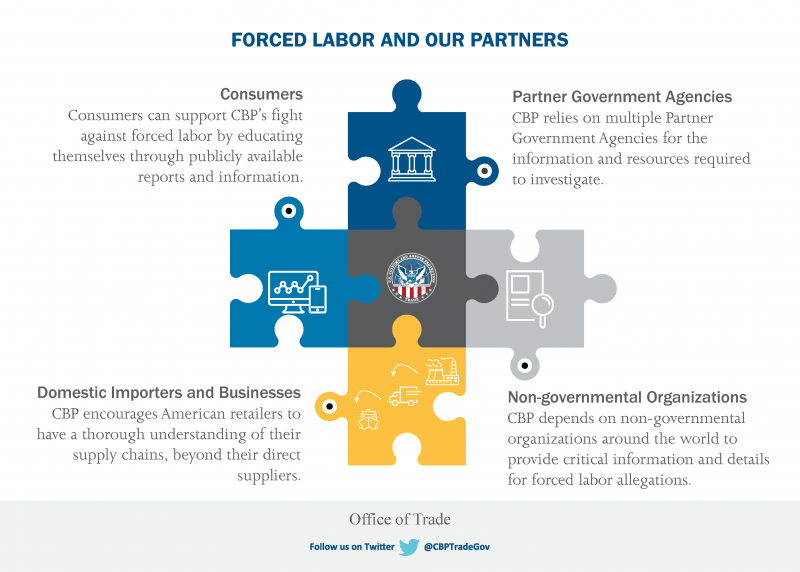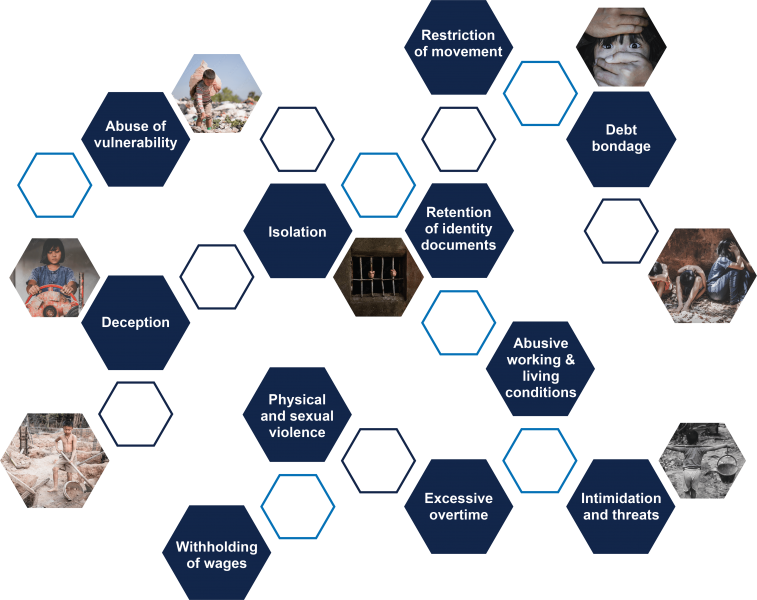What is Forced Labor?
CBP defines forced labor as all work or service which is exacted from any person under the menace of any penalty for its nonperformance and for which the worker does not offer work or service voluntarily. Indentured labor is defined as work or service performed pursuant to a contract, the enforcement of which can be accomplished by process or penalties. This includes forced or indentured child labor.
CBP Forced Labor Enforcement Process

How does CBP address Forced Labor?
CBP implements Section 307 of the Tariff Act of 1930 (19 U.S.C. 1307) through issuance of Withhold Release Orders (WRO) and findings to prevent merchandise produced in whole or in part in a foreign country using forced labor from being imported into the United States.
CBP is responsible for preventing the entry of products made with forced labor into the U.S. market by investigating and acting upon allegations of forced labor in supply chains.
The Human Trafficking Legal Center's June 2020 guide, Importing Freedom: Using the U.S. Tariff Act to Combat Forced Labor in Supply Chains, may be used to help the trade community strengthen petitions to CBP, and is one of several suggested tools to combat forced labor.
Withhold Release Orders and Findings List
Are your imported goods subject to a WRO or Finding? Check the Withhold Release Orders and Findings List for information on any merchandise that may be subject to exclusion and/or seizure. It is your obligation to be aware of your supply chain activities.
Forced Labor Statistics: Enforcement Actions
Total Active |
FY 2023 Statistics |
||||
|---|---|---|---|---|---|
9 |
Findings |
0 |
Findings Issued | ||
55 |
Withhold Release Orders |
1 |
Withhold Release Orders Issued | ||
0 |
Withhold Release Orders & Findings Modified or Revoked | ||||
3,605 |
Entries Targeted* | ||||
0 |
Penalties Issued | ||||
| * To better align CBP modernization efforts with detention data, the entry information above covers forced labor related targeted entries, which encompasses entries subject to detentions, that occurred between October 1, 2021, and September 30, 2022. Published quarterly. | |||||
The Uyghur Forced Labor Prevention Act
The Uyghur Forced Labor Prevention Act (UFLPA) establishes a rebuttable presumption that the importation of any goods, wares, articles, and merchandise mined, produced, or manufactured wholly or in part in the Xinjiang Uyghur Autonomous Region of the People’s Republic of China, or produced by certain entities, is prohibited by Section 307 of the Tariff Act of 1930 and that such goods, wares, articles, and merchandise are not entitled to entry to the United States.
The UFLPA rebuttable presumption went into effect on June 21, 2022. Please visit our UFLPA webpage for all updates on implementation.
What are the indicators of Forced Labor?
The indicators listed below were developed by the International Labour Organization. They are intended to help “front-line” criminal law enforcement officials, inspectors, trade union officers, NGO workers, and others to identify persons who are possibly trapped in a forced labor situation, and who may require urgent assistance. These indicators represent the most common signs that point to the possible existence of a forced labor case.
ILO indicators of Forced Labor
Images above obtained via Adobe Stock.
- CBP Timelines and Investigative Benchmarks for Forced Labor Petitions
- How Does CBP Enforce 19 U.S.C. 1307?
- How are Modifications and Revocations Processed?
- What is in a Petition for a Modification or Revocation?
- What Can Importers Do to Help Combat Forced Labor?
- Due Diligence in Global Supply Chains
China
- On July 13, 2021, the U.S. Department of State, alongside the U.S. Department of the Treasury, the U.S. Department of Commerce, the U.S. Department of Homeland Security, the Office of the U.S. Trade Representative, and the U.S. Department of Labor issued an updated Xinjiang Supply Chain Business Advisory to highlight the heightened risks for businesses with supply chain and investment links to Xinjiang, given the entities complicit in forced labor and other human rights abuses there and throughout China. This updates the original Xinjiang Supply Chain Business Advisory issued by U.S. government agencies on July 1, 2020.
North Korea
- CBP and ICE, with the U.S. Department of State, and the U.S. Department of the Treasury's Office of Foreign Assets Control (OFAC), issued the North Korea Sanctions and Enforcement Actions Advisory: Risks for Businesses with Supply Chain Links to North Korea on July 23, 2018. The advisory informs the trade of North Korea's evasion tactics, compliance risks and requirements, as well as due diligence best practices.

CBP encourages stakeholders in the trade community to closely examine their supply chains to ensure goods imported into the United States are not mined, produced or manufactured, wholly or in part, with prohibited forms of labor, i.e., slave, convict, indentured, forced or indentured child labor.
CBP regulations state that any person who has reason to believe that merchandise produced by forced labor is being, or is likely to be, imported into the United States may communicate his belief to any Port Director or the Commissioner of CBP (19 CFR 12.42).
If you wish to report allegations of forced labor violations, please submit them to CBP at the following address: https://eallegations.cbp.gov/Home/Index2. Allegations may be reported anonymously. The more detailed and timely the information you provide, the more likely the enforcement action can be successful.
- If you are a member of the media, please visit the Office of Public Affairs at https://www.cbp.gov/newsroom/press.
- If you would like information about CBP's Forced Labor program, please contact https://help.cbp.gov.

- CBP hosts trade outreach events via free webinars, including those on forced labor, to the international trade community on CBP trade policy, as established by the agency.
- CBP Trade Week has been held virtually since 2020, and has featured panel discussions and presentations on trade topics, including forced labor. The 2021 session discussed the evolution of forced labor enforcement with emphasis on current issues and future direction.
- 11-23-2022. CBP Issues Withhold Release Order on Central Romana Corporation Limited
- 09-07-2022. CBP Modifies Withhold Release Order on Natchi Apparel (P) Ltd.
- 01-28-2022. DHS Takes Action to Combat Forced Labor and Hold Companies Accountable for Exploiting Workers
- 12-20-2021. CBP issues Withhold Release Order on Brightway Group
- 11-04-2021. CBP Issues Withhold Release Order on Malaysian Glove Producers
- 10-21-2021. CBP Issues Withhold Release Order on Tomatoes Produced by Farm in Mexico
- 10-20-2021. CBP Issues Withhold Release Order on Supermax Corporation Bhd. and its Subsidiaries
- 09-10-2021. CBP Modifies Forced Labor Finding on Top Glove Corporation Bhd.
- 08-04-2021. CBP issues Withhold Release Order on Seafood Harvested with Forced Labor by the Hangton No. 112
- 07-23-2021. CBP Modifies Withhold Release Order on Imports of Carpets and Hand-Knotted Wool Products from Nepal
- 06-23-2021. The Department of Homeland Security Issues Withhold Release Order on Silica-Based Products Made by Forced Labor in Xinjiang
- 05-26-2021. CBP issues Withhold Release Order on Chinese fishing fleet
- 05-21-2021. CBP modifies Withhold Release Order on certain tobacco imports from Premium Tobacco Malawi Limited
- 03-29-2021. CBP Issues Forced Labor Finding on Top Glove Corporation Bhd.
- 01-13-2021. CBP Issues Region-Wide Withhold Release Order on Products Made by Slave Labor in Xinjiang
- 12-31-2020. CBP Issues Withhold Release Order on Seafood Harvested with Forced Labor by Lien Yi Hsing No. 12
- 12-30-2020. CBP Issues Withhold Release Order on Palm Oil Produced by Forced Labor in Malaysia
- 12-04-2020. CBP Modifies Withhold Release Order on Imports of Bone Black from Bonechar Carvão Ativado do Brasil Ltda



